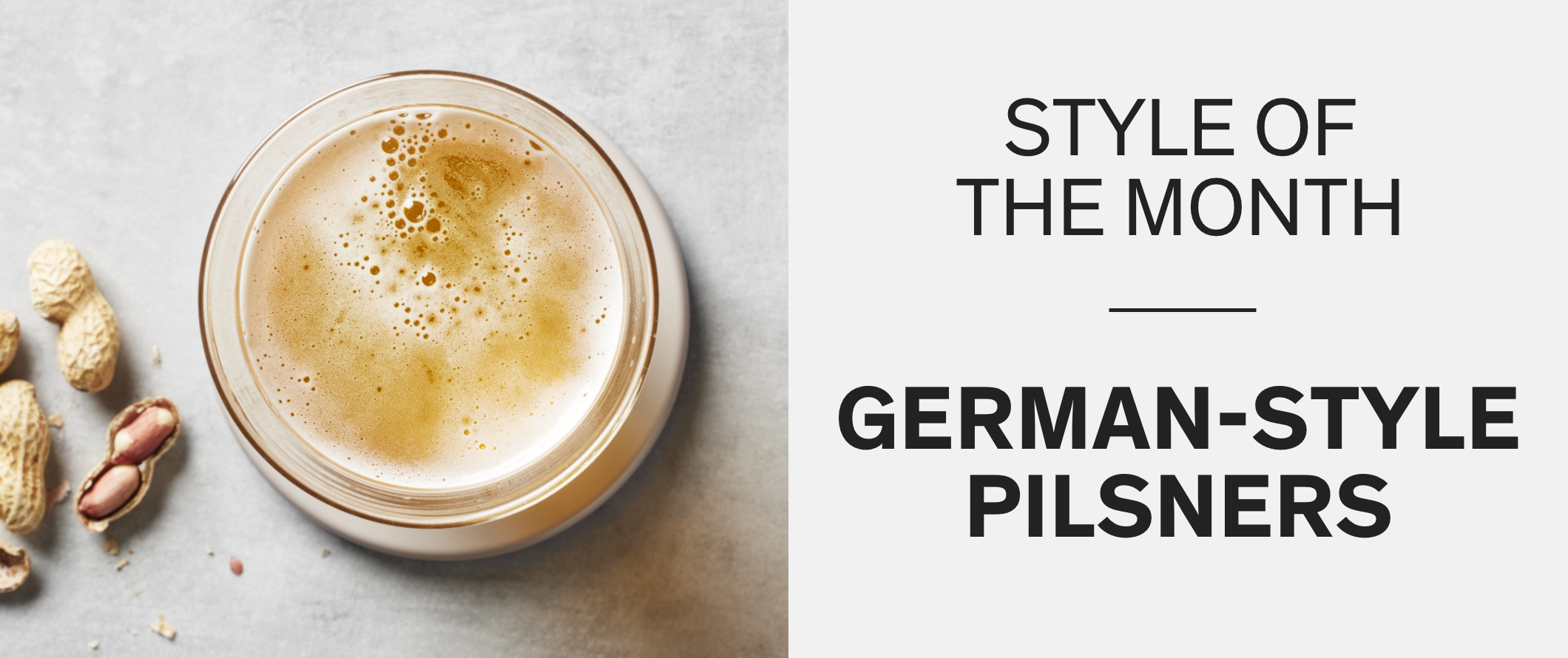German-Style Pilsners

Known in Germany simply enough as “Pils,” German-style Pilsners are a regional twist on a proud central European tradition of making crowd-pleasing, light-bodied, crisp and golden beers with a famously creamy foam top.
Ready to Explore
Although Pilsner was first invented in Czechoslovakia in the 1840s, it didn’t take long for German brewers to come up with their own take on it—an even more refined version of this refreshing and straightforward beer. It took off, especially in the north of Germany, where this straw-coloured beer quickly became a staple at beer gardens in cities like Hamburg and Berlin. A century and a half later, it’s still going strong and, not only are German pilsners currently being made in craft breweries around the world, some of today’s biggest international brands were originally inspired by this truly iconic style of beer.
You May Taste
You won’t find a lot of exotic or esoteric ingredients in a German-style Pilsner, a beer known for being considerably less sweet and malty than other beers—even other pilsners. Despite the light touch on the malt, there’s plenty of powerful flavour in a Pils, thanks to a precise mastery of the fermentation process and a “late-hopping” technique that sees “noble” German hops, such as Tettnanger and Spalt, added near the end of the kettle boil. The end result is a fresh and well-carbonated beer that usually has a lightly floral aroma, punchy spice, herbal and sometimes even earthy notes and a distinct “cracker” flavour.
Sip Them With
Most pairing suggestions see Pils matched up with light lunch fare, such as salads, chicken or tuna, but there’s a whole world of fragrant and spicy food, from pork fried rice to ginger and sesame noodles, that play well with German-style pilsner. And, of course, you can never go wrong with a cheese plate, especially one that’s heavy on fruit like green apples and pickled fennel.
Serving Tips
Although it doesn’t need to be quite as icy as a standard light lager, Pils wants to be cold—somewhere in between three and seven degrees Celsius—so that it’s easy to enjoy the crisp and refreshing character but still taste the lively flavour delivered by the unique hops. Serve in a tall, narrow pilsner glass or, if preferred, a nicely chilled beer stein.
Try These Picks
Discover More Beer Styles
Beer FAQs
Your Top Questions Answered

What is craft beer?
Craft beer is made by small-scale breweries, often independently owned, that practise traditional artisanal brewing techniques to create authentic and uniquely flavourful beers. These craft brewers may focus on either classic or lesser-known styles of traditional beer, or create innovative new modern brews.

How many calories are in a beer?
A standard 340-millilitre or 12-ounce beer that has five per cent alcohol by volume has about 150 calories. Styles of beer that contain more alcohol, such as IPAs, have more calories — up to 170. Light beers, which have less alcohol, have around 100 calories. While darker beers sometimes have a higher alcohol content and therefore more calories, that’s not always the case: consider Guinness Draught, a dark stout, which has just over four per cent alcohol by volume and 125 calories per 12 ounces.

How many beers are in a keg?
Most standard North American kegs hold 58.7 litres: in terms of standard 340-millilitre or 12-ounce bottles or cans, that’s 165 servings; if you’re counting by 16-ounce pints, its 124 servings. European beers often come in 50-litre kegs, yielding 140 340-millilitre glasses or 105 pints. Smaller 30-litre kegs (sometimes called “pony kegs”) give 82 standard beers or 62 pints. Mini-kegs (Heineken, for example) hold five litres: that’s about 10 pints or 14 glasses.

How is beer made?
All beer is made with four key ingredients: barley (or other grains), water, hops and yeast. First, barley is malted (meaning the grains are sprouted and then kiln-dried) to get ready for brewing. The malt is then mashed, or cooked with warm water, to create a sugary liquid called wort. The wort is boiled with flavouring hops, and then in the final step, it’s fermented with yeast, which creates the alcohol and finished beer.
There are many different styles and regional traditions of brewing, but to simplify, they basically fall into two categories: for ale, the beer is stored at room temperature while the yeast feeds on the sugar in the wort and produces CO2 and alcohol as by-products; for lager, fermentation is the same, but it happens at cooler temperatures so the process takes a little longer

How long does beer last?
Check for an expiry or best-before date on bottles and cans: “best” is best when consumed fresh. Bottles and cans stored at room temperature are safe to drink for at least four months after purchase and up to eight months when it’s stored in the refrigerator or a cool place. Draft or craft beer stored in a glass bottle keeps for two or three days in the refrigerator when tightly capped. And remember, keep beer away from light: it can develop a “skunky” flavour from a chemical reaction to UV light, which is why it’s usually packaged in cans or dark glass bottles.

What is beer made of?
Most beer is made from just barley, water, hops and yeast. That’s all! Each ingredient contributes to the beer’s flavour, as do the specifics of the production process. Some brewers may use other grains, such as corn, rye, rice, wheat or even oats, to produce different types of beer. Some styles even incorporate additional flavouring ingredients, including fruits and herbs.


